Now I tried to apply that to the parallel tank circuit, I get :
$$Q = RC\omega_0 + \frac{R}{\omega L}$$.
Q-factors don't combine this way. For a parallel RLC circuit at resonance the reactance is infinite with a phase angle of zero. But current circulates back and forth between L and C just the same.
For the passive components in parallel, the Q-factors are given as shown in the OP.
$$Q_{L}=\frac{R}{L\omega},Q_{C}=RC\omega$$
These Q-factors are frequency dependent.
If the energy stored in the capacitor (or inductor) is summed over one cycle you get zero. The capacitor and the inductor still provide storage at the same time. They are very active.
The Q for the parallel RLC, \$Q_P\$ is obtained using the geometric mean.
$$Q_{P}=\sqrt{Q_{L}Q_{C}}=\sqrt{\frac{R}{L\omega}RC\omega}=R\sqrt{\frac{C}{L}}$$
Notice that \$Q_P\$ is not frequency dependent.
This is validated with the result from 2nd order analysis of the circuit. Compare the first degree terms of the characteristic polynomial (CP):$$s^2+\frac{1}{RC}s+\frac{1}{LC}$$ with the standard form, $$s^2+\frac{\omega_0}{Q}s+\omega_0^2.$$ Solving for Q will give the same expression.
Notice that the centre frequency \$\omega_0=\omega_N\$, the natural frequency.
However in the lecture notes and the textbook the formula used is:$$Q=RC\omega_0$$
The expression for \$Q_P\$ can be manipulated:
$$Q_{P}=R\sqrt{\frac{C}{L}}=R\sqrt{\frac{C^{2}}{LC}}=RC\omega_{0}$$
Question is: Why is the inductor ignored in this formula?
It isn't ignored. It is included with \$\omega_0\$. \$Q_P\$ can also be written:
$$Q_{P}=R\sqrt{\frac{C}{L}}=R\sqrt{\frac{LC}{L^2}}=\frac{R}{L\omega_{0}}$$
Extras, but related
The magnitude response at the high and low cutoff frequencies must be equal so \$\frac{H(\omega_h)}{H(\omega_l)}=1\$. Solve for the centre frequency to show that \$\omega_0=\sqrt{\omega_h\omega_l}\$.
The phase at the corner frequency is \$45^0\$. So the tangent, \$\frac{\omega_{0}\omega_{l}}{Q_P\left(\omega_{0}^{2}-\omega_{l}^{2}\right)}=1\$ can be used to show that \$Q_P=\frac{\omega_0}{\omega_h-\omega_l}\$, the centre frequency divided by the bandwidth.
